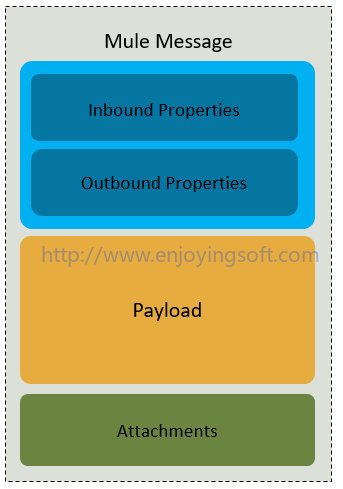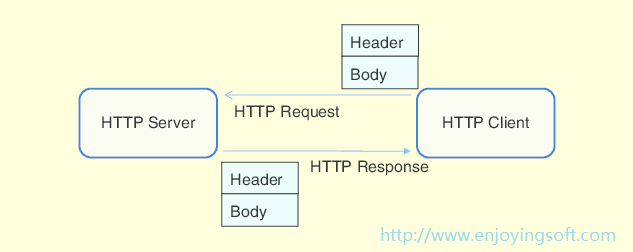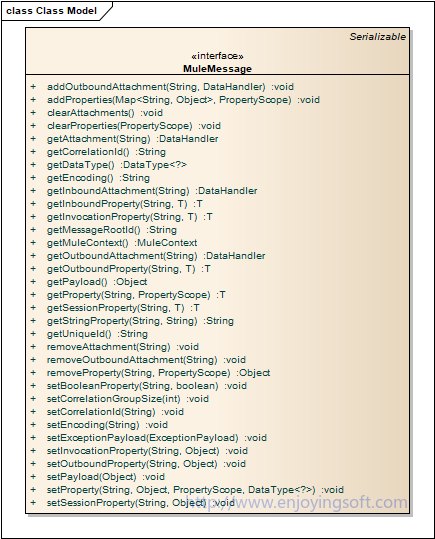EnjoyingSoft之Mule ESB开发教程第三篇:Mule message structure - Mule message结构
Mule ESB是一个使用Java语言编写的开源企业服务总线,企业服务总线英文Enterprise Service Bus,简称ESB。其相关源代码也托管在GitHub上,可以在https://github.com/mulesoft/mule这里找到相关的Source Code。
MuleESB在众多开源的ESB中处于领先者的地位,已拥有超过数百万的下载量,以及来自世界各地数十万个开发人员。MuleSoft公司也作为开源软件中的独角兽,2017年在纽交所成功上市。我们作为MuleSoft的重要合作伙伴也参与其中,在六年多的时间里,使用Mule ESB社区版实施,或者Mule ESB企业版实施,构建众多Mule ESB开发案例,帮助国内众多的企业成功上线企业集成项目。
我们使用Mule ESB开发的过程中,体会到它优秀的架构设计和高效的开发速度。同时也深感Mule ESB书籍,Mule ESB中文文档资料非常稀少,所以使用8篇文章来写Mule ESB的基础课程系列,讲解Mule ESB功能和开发。
- EnjoyingSoft之Mule ESB开发教程第一篇:初识Mule ESB
- EnjoyingSoft之Mule ESB开发教程第二篇:Mule ESB基本概念
- EnjoyingSoft之Mule ESB开发教程第三篇:Mule message structure - Mule message结构
- EnjoyingSoft之Mule ESB开发教程第四篇:Mule Expression Language - MEL表达式
- EnjoyingSoft之Mule ESB开发教程第五篇:控制消息的流向-数据路由
- EnjoyingSoft之Mule ESB开发教程第六篇:Data Transform - 数据转换
- EnjoyingSoft之Mule ESB开发教程第七篇:SOAP Web Service的消费和创建
- EnjoyingSoft之Mule ESB开发教程第八篇:使用API构建Rest Service
1. 探索Mule Message结构
很多开发者在开始使用Mule开发,很大原因是因为Mule的图形化开发环境非常友好,同时Mule Esb Transport也非常多,但对Mule最重要的Mule message概念并不特别熟悉。本篇重点讲解Mule的Message。
在上一篇教程中已经说到,Flow的结构和构成元素,在Flow中流动的就是Mule Message。

Mule Message是一个数据结构,也有相对应的Java Class。它包括几部分Payload,Property,Attachment。如下图所示:

如何理解这幅图,大致可以和HTTP协议类比。
-
Property
Mule Message的Property又分成Inbound Properties和Outbound Properties。这一点类似于HTTP协议的请求头和响应头。
-
Payload
Mule的Payload是一个对象,类型是不固定的。可能是Stream,也可能是Hashmap,也可能是XML字符串。这一点类似于HTTP协议的请求正文,或者说是请求体。
-
Attachment
Mule的Attachment就是消息的附件,这一点类似于HTTP协议中的multipartform-data请求。

如果你想看到整个MuleMessage的结构,使用Mule的Logger组件可以很方便的看到Message完整的组成。使用Logger打印出message,logger组件会重载message的toString方法,打印出Pretty格式的message。
<?xml version="1.0" encoding="UTF-8"?>
<mule xmlns:http="http://www.mulesoft.org/schema/mule/http" xmlns="http://www.mulesoft.org/schema/mule/core" xmlns:doc="http://www.mulesoft.org/schema/mule/documentation"
xmlns:spring="http://www.springframework.org/schema/beans"
xmlns:xsi="http://www.w3.org/2001/XMLSchema-instance"
xsi:schemaLocation="http://www.springframework.org/schema/beans http://www.springframework.org/schema/beans/spring-beans-current.xsd
http://www.mulesoft.org/schema/mule/core http://www.mulesoft.org/schema/mule/core/current/mule.xsd
http://www.mulesoft.org/schema/mule/http http://www.mulesoft.org/schema/mule/http/current/mule-http.xsd">
<http:listener-config name="HTTP_Listener_Configuration" host="0.0.0.0" port="8081" doc:name="HTTP Listener Configuration"/>
<flow name="loggertestFlow">
<http:listener config-ref="HTTP_Listener_Configuration" path="/" doc:name="HTTP"/>
<set-payload value="#["Mule Message"]" doc:name="Set Payload"/>
<logger message="#[message]" level="INFO" doc:name="Logger"/>
</flow>
</mule>
我们可以从下图的记录中找到和上图Message Structure相对应的节点。出于篇幅原因,做了简略处理。
org.mule.DefaultMuleMessage
{
id=f88d0090-074c-11e9-89b7-0c5415358ba9
payload=java.lang.String
correlationId=<not set>
correlationGroup=-1
correlationSeq=-1
encoding=UTF-8
exceptionPayload=<not set>
Message properties:
INVOCATION scoped properties:
INBOUND scoped properties:
accept=*/*
accept-encoding=gzip, deflate, br
accept-language=zh-CN,zh;q=0.9,en;q=0.8
cache-control=no-cache
connection=keep-alive
content-length=2
content-type=text/plain;charset=UTF-8
host=localhost:8081
http.listener.path=/
http.method=POST
http.query.params=ParameterMap{[]}
http.query.string=
http.relative.path=/
http.remote.address=/127.0.0.1:57630
http.request.path=/
http.request.uri=/
http.scheme=http
http.uri.params=ParameterMap{[]}
http.version=HTTP/1.1
SESSION scoped properties:
}
2. Mule Message的Payload
Payload翻译成中文是负荷,负载的意思。它是Mule Message的主要部分,也是Mule处理的主要对象。我们后续说的数据转换就是对Payload的转换。注意Mule Message的Payload是有可能为空的,比如接收到一个Http Get请求,Http Get请求的请求体是空的,所以这个时候Mule Message的Payload是空的。
在Flow中,最常用的动作就是给payload赋值,给Payload赋值会使用set-payload组件。如果我们在Flow中想获取payload,可以使用MEL表达式。
下面的源代码表示payload的赋值和取值。
<flow name="payloadFlow">
<http:listener config-ref="HTTP_Listener_Configuration" path="/" doc:name="HTTP"/>
<set-payload value="#["Mule Message"]" doc:name="Set Payload"/>
<logger message="#[payload]" level="INFO" doc:name="Logger"/>
</flow>
3. Mule Message的Property
Mule Message的Property是一个键值对,有name和对应的value。Mule Message有两种类型的Property,Inbound Properties和Outbound Properties。Inbound Properties或者Outbound Properties可以有多个Property,也就是多个键值对。
Inbound Properties是不可变的,是由Message Source产生的。就类似于Http的请求参数,是由用户的数据请求,经过Java的Servlet,或者Asp.Net等框架封装成Http Request对象。
Outbound Properties是可变的,我们在Mule的Flow中新增或者改变这些属性。注意,比如转换器,有些Mule Processor会自动增加有些属性。
在Mule中设定Property使用set-property组件,如果需要获取,同样使用MEL表达式。详细的MEL表达式,我们下篇会展开讲解。
<flow name="propertyFlow">
<http:listener config-ref="HTTP_Listener_Configuration" path="/" doc:name="HTTP"/>
<set-property propertyName="#["userName"]" value="#["Tom"]" doc:name="Property"/>
</flow>
4. Mule Message的Attachment
Attachment,正如字面上意思,可以理解成消息的附件。想象一封邮件,有邮件发送人等头信息,也有邮件正文,同样还有邮件附件。和Property一样,Attachment也有两种类型,Inbound Attachment和Outbound Attachment。我们通常将一些大的对象作为附件传输。
使用set-attachment设置附件,这里将payload作为pdf文档附件供消费者下载。
<flow name="attachmentFlow">
<http:listener config-ref="HTTP_Listener_Configuration" path="/" doc:name="HTTP"/>
<set-attachment attachmentName="#["doc"]" value="#[payload]" contentType="application/pdf" doc:name="Attachment"/>
</flow>
5. Mule的Variable
Variable也就是变量,有几种类型的变量,或者说几种不同范围的变量,如下:Flow Variable,Session Variable,Record Variable。Flow Variable在一个Flow是有效的,Session Variable是可以跨Flow的,Record Variable则是处理数据列表时会用到。
这里不详细讲述。从使用上说,有些类似于Java里面的局部变量,Session变量,但不完全一致。后续实战文章会分析这一点。
在Mule里,使用set-variable和MEL表达式对变量做赋值和取值操作。
<flow name="variableFlow">
<http:listener config-ref="HTTP_Listener_Configuration" path="/" doc:name="HTTP"/>
<set-variable variableName="orderNo" value="#["1238"]" doc:name="Variable"/>
</flow>
6. 使用Java操作Mule Message
对程序员来说,千言万语不如代码,如何使用Java操作Mule Message呢?通过Java代码我们可以清楚的看到Mule Message的结构,成员变量和方法等。
public void explorMessage(MuleMessage message) {
// 获取InboundProperty
String requestPath = message.getInboundProperty("http.request.path");
// 设定OutboundProperty
message.setOutboundProperty("content-type", "application/json");
// 获取Payload
Object payload = message.getPayload();
// 获取InboundAttachment
DataHandler fileAttachment = message.getInboundAttachment("fileName");
// 获取flow变量
message.getProperty("flowVarTest", PropertyScope.INVOCATION);
}
下图是Mule Message的类图,类图中只列表了重要的方法和属性。

本文同步发文于EnjoyingSoft Blogs ,CSDN,简书
访问EnjoyingSoft 网站,获取更多Mule ESB 社区版 实施帮助。
欢迎转载,但必须保留原文和此段声明,且在文章页面明显位置给出原文链接,否则保留追究法律责任的权利。



 浙公网安备 33010602011771号
浙公网安备 33010602011771号